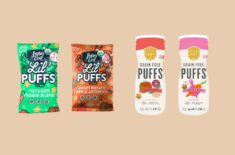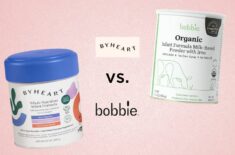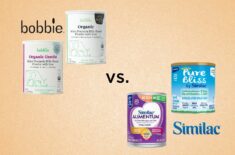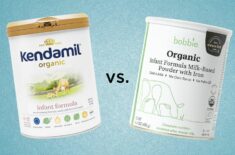Can Baby-Led Weaning Cause Choking?
Did you know that around 12,435 children under 14 years of age are treated in US hospitals annually because of choking? Around 37.8% of these cases are children in their first year. (1)
Choking is one of the top fears of parents starting their babies on solids.
It can be scary to see your baby gag on food or purées.
Interestingly, studies actually show that babies might have the same risk of choking during BLW (baby-led weaning) as infants following traditional spoon-feeding. (2)(3)(4)
Still, with proper safety checks and preparation, choking may be prevented.
It’s important to ensure that you offer foods with a lower risk of choking, no matter what weaning approach you choose.
Your pediatrician can also provide you with more information about avoiding choking hazards and preparing foods that are safe for your child to eat.
Can a six-month-old choke on finger food or toast? Can a baby choke on bananas, scrambled eggs, peas, rice, or soft food? Are there other ways to prevent baby-led weaning choking besides eliminating these food hazards?
Find answers to these questions and learn more about BLW choking below.
How Often Do Babies Choke During Baby-Led Weaning?
As many as 35% of babies between six to eight months of age may experience choking at least once. But studies show that infants following the baby-led weaning method may not be more likely to choke than spoon-fed babies. (2)(3)(4)
Based on these studies, infants can choke whether they’re following the traditional spoon-fed weaning method or BLW (baby-led weaning) approach.
What Do Babies Choke On Most?
Food is the most common cause of choking incidents, but many toys and household items are also considered a choking hazard.
From 2001 to 2009, as many as 111,914 children were hospitalized in the US for nonfatal food-related choking. (1)
Of all food types, the following accounted for the most number of choking incidents: (1)
- Hard candy (15.5% or 16,168 cases); read about candy recalls here
- Other types of candy (12.8% or 13,324 cases)
- Meat (12.2% or 12,671 cases)
- Bone (12.0% or 12,496 cases)
The New York State Department of Health educates parents that a young child’s windpipe (trachea or airway) is approximately the size of a drinking straw. (5)
That’s one of the reasons why choking is the fourth most common cause of unintentional deaths in children under five years of age. (5)
To reduce choking risks, keep small, hard objects (food and non-food) out of your child’s reach.
Can A 6-Month-Old Choke On Finger Food?
Yes, a child this age (or even older) can choke on finger food.
To reduce the risk of choking incidents, avoid hard foods that your child will have difficulty chewing and swallowing. Instead, choose soft finger foods, such as steamed carrots or chicken drumsticks (cooked until tender).
Can My 6-Month-Old Choke On Toast?
Yes, your little one can choke on toast at this age. To help prevent that from happening, remove the crust and lightly toast the bread before cutting it into bite-sized pieces appropriate for their age.
You can also cut the toast into strips so that your child can hold one end while nibbling from the other.
Can A Baby Choke On Banana?
Bananas aren’t considered a common choking hazard, but they may cause gagging because they can get stuck inside your baby’s mouth.
Still, you have to watch your child closely while eating because even a toothless baby can easily cut off a large piece that might be too big for them to swallow. It can potentially be a choking hazard.
Note that processed bananas like chips or dried bananas can be a choking hazard because they’re too hard for your baby to chew.
Can A Baby Choke On Scrambled Eggs?
Scrambled eggs aren’t considered a common choking hazard, but you still have to be careful if your child takes bigger bites that they can’t swallow properly. The food can get stuck in their throat.
To serve scrambled eggs, make sure you cut them in bite-sized pieces appropriate for their age.
Is Rice A Choking Hazard For Babies?
Yes. Surprisingly, rice and other grains are considered a choking hazard by the CDC (Center for Disease Control and Prevention). (6)
Rice and other grains like quinoa and oats are small and aren’t likely to block your baby’s throat. But the pieces can scatter while your baby eats and get aspirated into their airway. It can lead to discomfort and lots of coughing.
Encourage your child to only take small bites to prevent that from happening. You can also mix the rice with hummus or yogurt to bind the grains together.
Also, ensure that your child sits upright properly to reduce the risk of food going to their airways.
If possible, however, avoid giving rice to your baby.
We don’t recommend rice as a main or regular part of babies’ diets because it contains high levels of arsenic, a heavy metal that may cause an increased risk of certain cancers. It can also lead to decreased IQ and brain or motor development problems. (7)(8)
Are Peas A Choking Hazard For An 11-Month-Old?
Peas are round and can sometimes get swallowed whole. But their diameter is too small to be considered a choking hazard for a child this age (if eaten individually).
Still, your child can potentially choke on peas if they eat more than one pea at a time. To prevent choking episodes with this food, you can lightly mash it so it won’t be round. You can also encourage your child to refrain from putting too much of it in their mouth.
Can Babies Choke On Soft Food?
Like hard foods, soft ones can cause gagging. But they’re rarely considered a choking hazard unless your child bites off a big chunk (such as a banana) that’s too large for them to swallow.
Still, kids in their first year up to three years old may have the highest risk of choking from food and non-food objects. So, it’s important to always supervise them while eating, even if you only give them soft foods.
How Do You Prevent Choking In Baby-Led Weaning?
Wait Until Your Child Is Ready
The American Academy of Pediatrics (AAP) recommends exclusive breastfeeding for babies six months of age and below. But some babies may already be ready for solid foods by four months of age. (9)
Every child is different, but your baby may be ready for solid foods if they show these signs:
- Sits up on their own (with or without support)
- Can control their neck and head
- Shows interest in food (opens mouth, leans forward, or tries to grab food)
- Swallows food instead of trying to push it out involuntarily (tongue-thrust reflex)
However, Dr. Gill Rapley, the pioneer of baby-led weaning, reminds parents to wait until their children are truly ready for solid foods. (10)
She explains:
“The problem is that it’s tempting to see more ability in one’s child than is actually there, and to offer just that little bit of help to enable them to achieve a particular goal.
Mostly, this doesn’t matter, but when it comes to eating, a baby’s ability – or inability – to manage the necessary sequence of actions is an important safety factor.
‘Helping’ them over a hurdle they cannot yet manage for themselves (e.g. by providing extra support to sit up or reach out, guiding their arm towards their mouth, or – worse – putting the food into their mouth ‘for them’) is potentially hazardous.”
Let Your Baby Self-Feed
The best way to support your child in baby-led weaning is to make sure you understand the concept and learn how to keep meals as safe as possible.
Dr. Rapley explains that trust is a big factor in BLW. You must trust your baby’s instincts and give them a chance to do things their way. (10)
She points out that a baby’s “achievement” is really an adult’s goal, not indicating the child’s success or failure.
So, if a child doesn’t manage to put food in their mouth, it’s not an actual failure. It may be because your child isn’t ready for it, despite showing signs of readiness.
It’s important to understand that your role in baby-led weaning is to give your child the opportunity to do whatever they’re ready for. You prepare safe and healthy foods for your child, but everything else is up to them.
You can’t help baby choose the foods you want them to eat or make them consume the meal faster. They should be allowed to pick what they want from what’s served, eat as much or as little of it, and complete the meal at their own pace.
Seek Advice From Health Professionals
Pediatricians, dietitians, nutritionists, and other health professionals can help you decide whether your child is ready for baby-led weaning.
They can also offer more information about choking hazards and how you can ensure your child’s safety during mealtimes.
The Difference Between Gagging & Choking
Although choking and gagging might seem similar, they’re different. (11)
Gagging is due to the baby’s gag reflex, a safety mechanism that can prevent choking.
You might also notice your child gag on the food they taste for the first time. It can happen whether you’re spoon-feeding them purée or they’re eating finger foods in baby-led weaning.
Signs of gagging can include:
- Loudly coughing, gurgling, or sputtering
- Bringing back or regurgitating food back into their mouth
- The tongue may be thrust forward
- Spitting up or vomiting
- Possibly red-faced
If you see these signs of gagging, don’t try to help your child or stop them from spitting up. Doing that can lead to choking.
Gagging is often mistaken for choking, but it’s really a normal part of trying new foods.
Recognize Early Signs Of Choking
Choking happens when something blocks your child’s airways. It’s important to remove this blockage as quickly but safely as possible.
Because it’s dangerous, you should learn to recognize these early signs of choking:
- Struggling to breathe or cough
- High-pitched sound while breathing
- Face and lips might turn blue
- Terrified look
Choking episodes can be quiet because your baby might have a hard time making a sound.
Limit Distractions
It might be easier to give spoon-fed infants some food when they’re distracted, but your child’s undivided attention is important in baby-led feeding. It can minimize choking incidents and let your child focus on the food and feeding themselves.
So, avoid letting your child watch TV, use the cellphone, or play with toys during mealtimes.
Always Watch Your Baby During Meals
The diameter of a young child’s airways is just around the size of a drinking straw, so they may also choke on a small piece of food.
Avoid multitasking while feeding your baby. Note that choking episodes can be quiet. You might not notice your child choking when you’re doing something else, even if you’re just an arm’s length away.
Recognize and Avoid High-Risk Choking Foods
The CDC considers the following as potential choking hazards for young children: (6)
Fruits And Veggies
- Whole corn kernels (cooked or raw)
- Whole cherry tomatoes
- Whole pieces of canned fruits
- Hard fruits or vegetables, such as raw apples or carrots
- Whole grapes, berries, cherries, or melon balls
- Dried vegetables or fruits, such as raisins
These foods may be safe for your baby if cooked until tender and cut into smaller, more manageable pieces.
Proteins
- Chopped or whole nuts and seeds
- Seed or nut butters, such as peanut butter (sticky consistency and especially with chunky bits)
- Large, tough chunks of meat
- Hot dogs, sausages, meat sticks, or other processed meats
- Large chunks of cheese, especially stickier ones like string cheese
- Bones in meat
- Fish with bones
- Whole beans
It may be alright to serve your child with meat on larger bones (such as ribs) but be careful of smaller, broken pieces of bones.
In giving meat to your baby, ensure that it’s cooked until tender.
Grain Products
- Cookies, teething biscuits, granola bars, or similar snacks
- Crackers
- Hard snack items like potato or corn chips, popcorn, or pretzels
- Bread with seeds, whole-grain kernels, or nut pieces
- Plain wheat germ
- Whole grain kernels of cooked wheat, barley, or other grains
Aside from being choking hazards, some of these grains (such as wheat, barley, and rye) contain gluten, a common allergen.
Sweetened Foods
- Round or hard candy, jelly beans, caramels, gumdrops, or gummy candies
- Chewy fruit snacks
- Chewing gum
- Marshmallows
Avoid giving sweetened foods to your baby. Aside from being choking hazards, these sweet treats lack nutritional value, and added sugar can increase the risk of obesity. (12)
Offer Foods Appropriate For Their Age
Prepare your baby’s foods according to their age and developmental stages.
For 4-9 Months
- You can give food slices or spears the size of two adult fingers’ width to children up to nine months old. They can hold on to the food while nibbling on the top portion.
- At this stage, they haven’t learned or mastered holding food with their thumb and index finger (pincer grasp), so they’ll usually curl all their fingers around the item before bringing it to their mouth.
- But you can slowly introduce them to cubes of soft fruits or cooked veggies as they get older.
- Meat on the bone (like ribs or drumsticks) can be ideal for your baby to nibble on some meat without choking on a large piece of whole bone.
For 9+ Months
- You can give them bite-sized food pieces.
- As they develop their pincer grasp, they can learn to pick up smaller pieces of food.
- Kids this age may already have some teeth they can use to chew on food, but refrain from giving them raw apples or other hard foods because these remain as choking hazards at this age range. It’s best to continue cooking these until soft before giving them to your baby.
When Can I Serve Harder Foods To My Baby?
- You may start giving harder foods like raw apples when your child is one year old and above. But still, ensure you supervise your child while eating so they won’t take big bites that are difficult to chew and swallow.
- Offer a variety of foods, but continue checking for potential choking hazards.
Choose A Proper Spot For Eating
- Don’t let your little one eat in the car unless someone who knows BLW and first aid is sitting with them.
- Avoid letting your child run, crawl, or walk around while eating.
- If possible, choose a proper highchair with a footrest.
Stability and balance are important in self-feeding safety. So, Dr. Rapley recommends getting a high chair with a footrest. (13)
If your baby is too tiny for the high chair you bought, she recommends putting a rolled-up towel around their hips to fill the space. A small towel placed between your child’s legs can also help them from sliding forward in a slippery high chair.
These high chairs with a footrest are adjustable and can grow with your baby:
Check Child’s Mouth After The Meal
If your child has already stopped eating, don’t try to make them eat more.
But you should check if there’s still some food left in their mouth because that can become a choking risk.
Check the roof of their mouth or the sides of their cheeks. But don’t stick your finger in.
Instead, encourage your child to drink some liquid (breastmilk, formula, or water) to swallow the food or continue chewing. If needed, you can also ask them to spit it out.
Learn First Aid
It’s a good idea to learn how to perform common first-aid procedures.
How can you help a choking baby? Perform the Heimlich maneuver to attempt dislodging the item that caused choking. (14)
Infants In Their First Year
- Have someone call emergency services.
- Put your baby facedown on your lap.
- Support their head with one hand.
- Use the base of your other hand to deliver five quick, forceful blows between their shoulder blades.
The blows can create a strong vibration that may help dislodge the blockage. But be careful not to hit too strongly because the force can also break your child’s back.
So, it’s important to know how to do it properly. You can attend live courses in your area or take online classes depending on where you live.
Children Older Than One Year OId
- Let someone call emergency services.
- Stand behind the choking child and wrap your arms around their waist.
- With your thumb in, make a fist with one hand.
- Put this fist slightly above your child’s navel but just below the chest.
- Grab the first hand and press your child’s abdomen with a quick upward push using your other hand.
- Repeat until the object is dislodged.
The sudden inward, upward thrusts may force the blockage out of your child’s mouth.
CPR (Cardiopulmonary Resuscitation)
This procedure should be done if your child is unresponsive or not breathing.
Because it’s an important procedure that can also potentially harm your child if done incorrectly, it’s best to learn it directly by attending first aid classes.
These procedures can save your baby’s life while you wait for emergency services to arrive.
Educate Caregivers About CPR Readiness And BLW
Other people who care for your child should also know about CPR readiness, basic first aid, and the principles of baby-led weaning.
This way, they’ll also learn to prepare the right baby foods, recognize choking signs, and ensure your child can eat independently but safely.
Should I Take My Baby To The Hospital After Choking?
Yes. Even after dislodging the blockage, it’s better to bring your child to the hospital after a choking episode because a piece of the food might have reached their lungs.
What To Watch For After Choking?
Bring your child to the ER if they continue to experience the following after choking:
- Coughing
- Wheezing
- Trouble breathing
- Trouble swallowing
- Frequently gags
- Drools
REFERENCES
(1) https://pubmed.ncbi.nlm.nih.gov/23897916/
(2)
Fangupo LJ, Heath AM, Williams SM, Erickson Williams LW, Morison BJ, Fleming EA, Taylor BJ, Wheeler BJ, Taylor RW. A Baby-Led Approach to Eating Solids and Risk of Choking. Pediatrics. 2016 Oct;138(4):e20160772. DOI: 10.1542/peds.2016-0772. Epub 2016 Sep 19. PMID: 27647715. https://pubmed.ncbi.nlm.nih.gov/27647715/
(3) https://www.ncbi.nlm.nih.gov/pmc/articles/PMC6202902/
(4) https://pubmed.ncbi.nlm.nih.gov/23183112/
(5) https://www.health.ny.gov/prevention/injury_prevention/choking_prevention_for_children.htm
(6) https://www.cdc.gov/nutrition/infantandtoddlernutrition/foods-and-drinks/choking-hazards.html
(7) https://www.fda.gov/files/food/published/Arsenic-in-Rice-and-Rice-Products-Risk-Assessment-Report-PDF.pdf
(8) https://www.ncbi.nlm.nih.gov/pmc/articles/PMC4779445/
(9) https://www.cdc.gov/nutrition/infantandtoddlernutrition/foods-and-drinks/when-to-introduce-solid-foods.html
(10) http://www.rapleyweaning.com/assets/How_early_is_too_early.pdf
(11) https://preventallergies.org/baby-gagging-vs-choking/
(12) https://www.ncbi.nlm.nih.gov/pmc/articles/PMC6959843/
(13) http://www.rapleyweaning.com/assets/Sitting_upright.pdf
(14) https://www.stanfordchildrens.org/en/topic/default?id=how-to-help-a-choking-child-1-197












